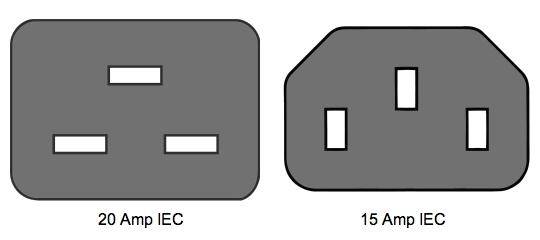AudioQuest Storm Series Thunder Power Cable
AudioQuest Storm Series Thunder Power Cable
Product questions? Found a lower price?
Let us know: 909.931.9686 or chat.
Couldn't load pickup availability
This item qualifies to earn HiFives. What's a HiFive?
View full details

AudioQuest Thunder / High-Current
An 11-gauge (12 AWG ground), solid LGC & PSC cable with ZERO Tech, GND, and 72 V DBS
“The experience of changing the stock cable on an amp to the AudioQuest Thunder is going to stay with me, because for the first time I clearly heard a huge, undeniable improvement from a power cable change alone. It was, in fact, so much like connecting the Niagara 1000 (using stock cable), that I recommend the Thunder cable as a significant upgrade, especially if your audio system is built around a high-quality component that does more than one thing, such as an integrated amp with a DAC.”
Low-Z / Noise-Dissipation 3-Pole AC Power Cable
- Solid Long-Grain Copper (LGC)/ Perfect-Surface Copper (PSC) Conductors
- Uncompressed High-Current Transfer
- Ground Noise Dissipation Technology (US Patent # 9,373,439)
- Zero Characteristic Impedance (50Hz – 1MHz)
- 72VDC Dielectric Bias System (US Patent #7,126,055)
- Directionally Controlled Conductors
THE CHALLENGE
Alternating Current (AC), is a far-from-perfect power source. AC power technology is well over a century old and was never designed to meet the exacting standards of today’s high resolution audio-video components. AC noise is present at the utility source, and is then exacerbated by radio frequency noise that is induced (picked up by the AC power cord) and coupled to the component power supplies and to circuit ground. This creates distortion and low-level signal losses via the “masking effect.” Further, power amplifiers can require immense reserves of transient current for their power supplies to react to and then stabilize during dynamic audio passages. Most AC power cords and power conditioner-regenerators, though helpful to a point, are simply not up to the task.
Power amplifiers present a real challenge for any AC power source, as the transient current requirements (though short in duration) can be many times that of the average (RMS) current consumption. Power amplifiers are also unique from all other components in that the current draw is dynamic, not constant, and it changes with volume and audio signal content. Though many AC power cords may feature low DC resistance to allow for some of this requirement, the characteristic impedance of the AC cable is equally responsible for assuring uncompromised performance. Many premium AC cords constrict or compress the audio transient as their characteristic impedance restricts the transient current.
THE SOLUTION
High-Purity Conductors: A carefully finessed combination of solid high-purity Long-Grain Copper (LGC) and high-purity Perfect-Surface Copper (PSC) conductors prevent strand interaction, a major source of ear fatiguing transient intermodulation distortion. LGC allows a smoother and clearer sound than standard OFHC (Oxygen-Free-High-Conductivity) copper.
The astonishingly smooth and pure Perfect-Surface Copper further eliminates harshness and greatly increases clarity compared to OFHC, OCC, 8N and other premium coppers.
Uncompressed High-Current Transfer: With current capacity of 20 amps RMS @ 125VAC 50/60Hz (16 amps RMS @ 220-240VA 50/60Hz), Thunder/High-Current can withstand current transient peaks many times its continuous (average) RMS rating. This makes Thunder/High-Current ideally suited for a wide assortment of AC power conditioners, power regenerators, AC isolation transformers, and AC battery back-up devices, as well as any power amplifier, powered subwoofer, powered loudspeaker, powered receiver, or integrated amplifier.
Ground Noise-Dissipation Technology: AC Ground wires provide protection from current-wiring faults, but they also act as antennas. Thus, they are subject to induced radio frequency (RF) noise. This RF noise bypasses component power supplies and is typically coupled directly into a system’s most sensitive audio-video circuits. AudioQuest’s patented Ground-Noise Dissipation greatly reduces this distortion, yielding unprecedented levels of noise dissipation across the widest bandwidth (range) of radio frequencies possible. Our unique circuit-topology utilizes a common-mode phase-cancelling array, in concert with proprietary dielectric materials which provide additional differential linear filtering.
Dielectric-Bias System (DBS; US Pat #7,126,055): By creating a constant dielectric field for the cable’s primary capacitance field or dielectric, DBS assures extended bandwidth and more evenly filtered noise dissipation, eliminating the distortions and ringing that plague other cables even after years of use and so called “run-in time.” In addition, DBS assures that the RF Noise-Dissipation System works as linearly as possible.
Controlled for Correct Directionality: All drawn metal strands or conductors have a non-symmetrical, and therefore directional, grain structure. AudioQuest controls the resulting RF impedance variation so that noise is drained away from where it will cause distortion.
HELP!!! Do I need 15 amp or 20 amp?
 Some gear might say they are 20 amp, but still use the 15-amp IEC connector. To determine which one you need for your application, take a look at this drawing of the two types of IEC connectors. Pick the one that matches the IEC socket on your gear.
Some gear might say they are 20 amp, but still use the 15-amp IEC connector. To determine which one you need for your application, take a look at this drawing of the two types of IEC connectors. Pick the one that matches the IEC socket on your gear.


